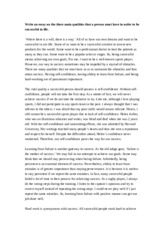Register to read the introduction…The reader is able to see this story though Jing-mei's eyes. This point-of-view helps the reader see her actions and feelings in a more personal way, rather then a third person presentation. One can actually understand the internal conflict more clearly. She lets her true identity poke through when she says, 'I am in China, I remind myself. And somehow the crowds don't bother me. It feels right. I start pushing too' (860). In this story, there really isn't anything disclosed to us which produces a bigger impact. This point-of-view plays a very crucial role in the stories central idea because allows us a personal view of Jing-mei, and a full understanding of her conflicting sense of identity. The primary setting of the story is in California during the year of 1987. The setting is pretty general, but there is really no need for it to be specific. The setting plays a key role in this story, because she struggles with her Chinese heritage as an American citizen living in the United States. The setting acts as an antagonist because her Chinese heritage causes her to feel out of place in her birthplace. California is the main contributor to the conflict, because there probably wouldn't be a conflict if she was born over in China to begin…show more content…
You can tell by the diction Jing-mei uses that she was born in America. Although she can understand Chinese, she cannot speak it. This in itself adds to the conflict, because she is unable to relate fully to her culture because of her language barrier. Also, all the other characters in the story speak 'the Mandarin dialect from their childhood' or 'the Cantonese of their village' (862). Jing-mei uses a lot of sensory images to describe her trip in to China. One example is when she examines their hotel room, 'The rugs, drapes, bedspreads are all in shapes of taupe. There's a color television with remote control panels built into the lamp table between the two twin beds' (864). An example of symbolism that really stands out is the doll that Jing-mei's mother passed down to her youngest niece. It was the indication that her mother's whole family was dead after she saw that her parents house had been bombed during the war. Then she explains to Jeng-mei, 'She cried if that doll was not with her always. Do you see? If she was in the house with that doll, her parents were there, and so everybody was there, waiting together, because that's how our family was' (861). Another example of symbolism is the letter that the twins sent to their mother, because it's a sign of closure and also marks a new beginning for Jeng-mei. Their mother spent her whole life searching for her twins, wondering if they were alive and well and completely clueless to their fate. When the letter arrives, it was a new beginning for Jing-mei and at the same time brought closure for their mother. This letter is crucial in helping Jing-mei accept her true identity as a result of her meeting her
You can tell by the diction Jing-mei uses that she was born in America. Although she can understand Chinese, she cannot speak it. This in itself adds to the conflict, because she is unable to relate fully to her culture because of her language barrier. Also, all the other characters in the story speak 'the Mandarin dialect from their childhood' or 'the Cantonese of their village' (862). Jing-mei uses a lot of sensory images to describe her trip in to China. One example is when she examines their hotel room, 'The rugs, drapes, bedspreads are all in shapes of taupe. There's a color television with remote control panels built into the lamp table between the two twin beds' (864). An example of symbolism that really stands out is the doll that Jing-mei's mother passed down to her youngest niece. It was the indication that her mother's whole family was dead after she saw that her parents house had been bombed during the war. Then she explains to Jeng-mei, 'She cried if that doll was not with her always. Do you see? If she was in the house with that doll, her parents were there, and so everybody was there, waiting together, because that's how our family was' (861). Another example of symbolism is the letter that the twins sent to their mother, because it's a sign of closure and also marks a new beginning for Jeng-mei. Their mother spent her whole life searching for her twins, wondering if they were alive and well and completely clueless to their fate. When the letter arrives, it was a new beginning for Jing-mei and at the same time brought closure for their mother. This letter is crucial in helping Jing-mei accept her true identity as a result of her meeting her



A Pair Of Tickets Story
PDF downloads of all 1379 LitCharts literature guides, and of every new one we publish. Detailed quotes explanations with page numbers for every important quote on the site. Teacher Editions with classroom activities for all 1379 titles we cover. Line-by-line modern translations of. The theme of Amy Tan’s short story “A Pair of Tickets” is the account of a young Chinese American, June May, who was born and raised in California and was in denial about her ethnic identity. She has reached middle-age and doesn’t know what it means to be Chinese. 【 A Pair of Tickets by Amy Tan Essay 】for free from best writers of Artscolumbia Largest assortment of free essays Find what you need here!.pdf.docx.epub.txt.
